Make sure all the players in your RevOps team understand the rules and operations of your organization.
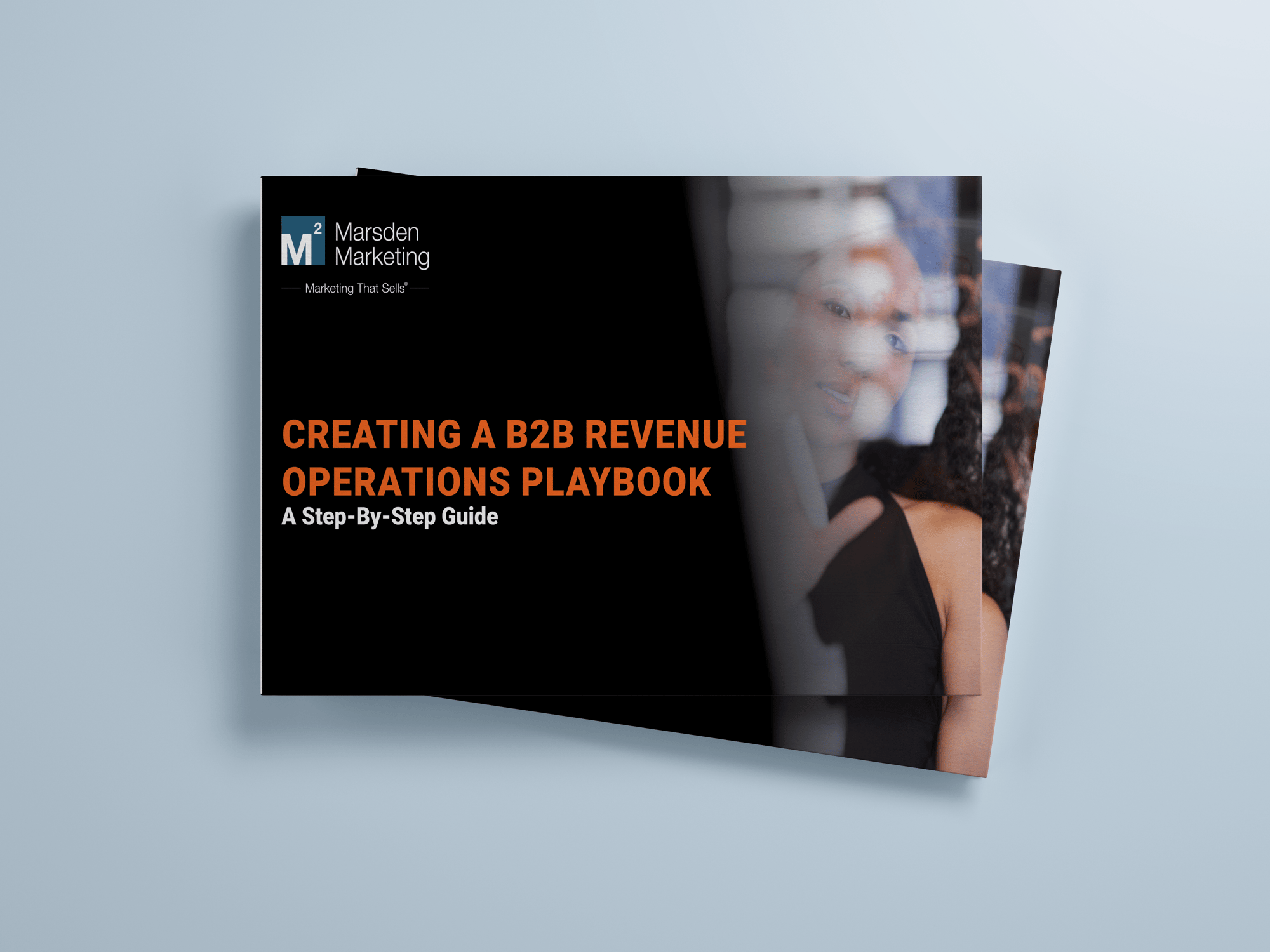
In January 1969, at the Orange Bowl in Miami, the first-ever official Super Bowl was about to begin. The Baltimore Colts looked set to cruise to victory.
A formidable collection of seasoned, talented athletes, the only thing standing between them and a place in the history books was the New York Jets, an NFL team with a relatively unimpressive record.
Any smart gambler would have put their money on the Colts… and they would have lost.
The Jets won this game, not because they were more skilled or experienced than the Colts, but because of exceptional teamwork and a keen understanding of their opponent brought together by a gifted coach. The same is true for businesses.
Companies that can bring their sales, marketing, and customer success/support teams together, ensuring alignment across multiple departments and functions, can achieve extraordinary results. They can even edge out competitors with far more experience and resources.
This is at the heart of Revenue Operations (RevOps). It brings all the right players — sales, marketing, and customer success/support — together so everyone is focused on continuously growing overall revenue. And companies that invest in RevOps report 10-20% increases in sales productivity. In addition, they have been shown to grow revenue 3x faster than those that don’t.
So how can you set yourself up for success? A Revenue Operations playbook is the best way to start.
Before we touch on the importance of a RevOps playbook and how to start building your own, it’s helpful to clarify what a “playbook” really is.
There are a few interpretations here, and it’s easy to fall into buzzword territory.
For some businesses, a playbook is no more than a document outlining standard operating procedures and guidelines. Others may include higher-level strategy and experience reports from other team members.
Some playbooks might include highly detailed educational resources and even mini courses. Some focus tightly on just one business area, whereas others are much more general.
At Marsden Marketing, we have our specific definition of what a playbook means to us within the RevOps context.
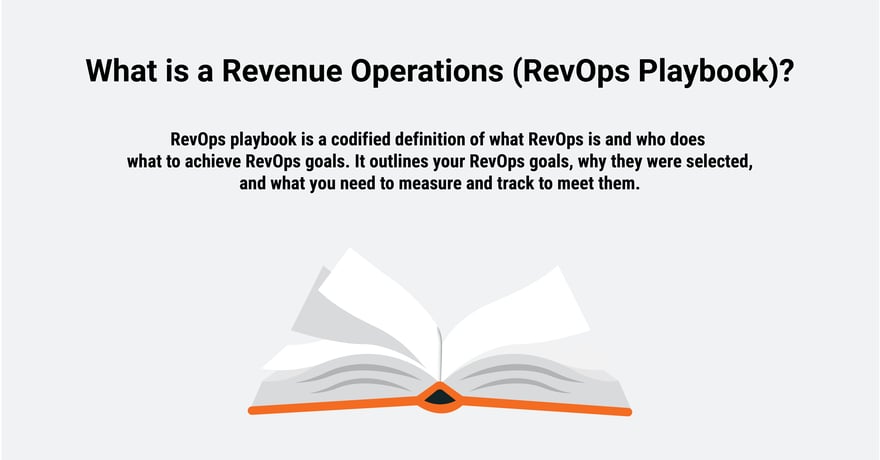
Essentially, a RevOps playbook is a codified definition of what RevOps is and who does what to achieve RevOps goals. To this end, the playbook should also clearly outline:
A well-structured RevOps playbook is the backbone of a successful Revenue Operations strategy. It ensures that everyone with a role within the RevOps function knows what’s involved. And it outlines the steps that are needed to implement a RevOps strategy and show each person involved in the RevOps function where their specific role comes into play.
Finally, a playbook shouldn’t be seen as a one-and-done activity. It’s a living document that should be updated and amended over time with new information. When somebody new joins your organization, your playbook should be the perfect starting point to bring them up to speed and eliminate a ton of learning time.
Now that you know what a RevOps playbook is and what it does, it’s time to look at some of the key reasons why you need one.
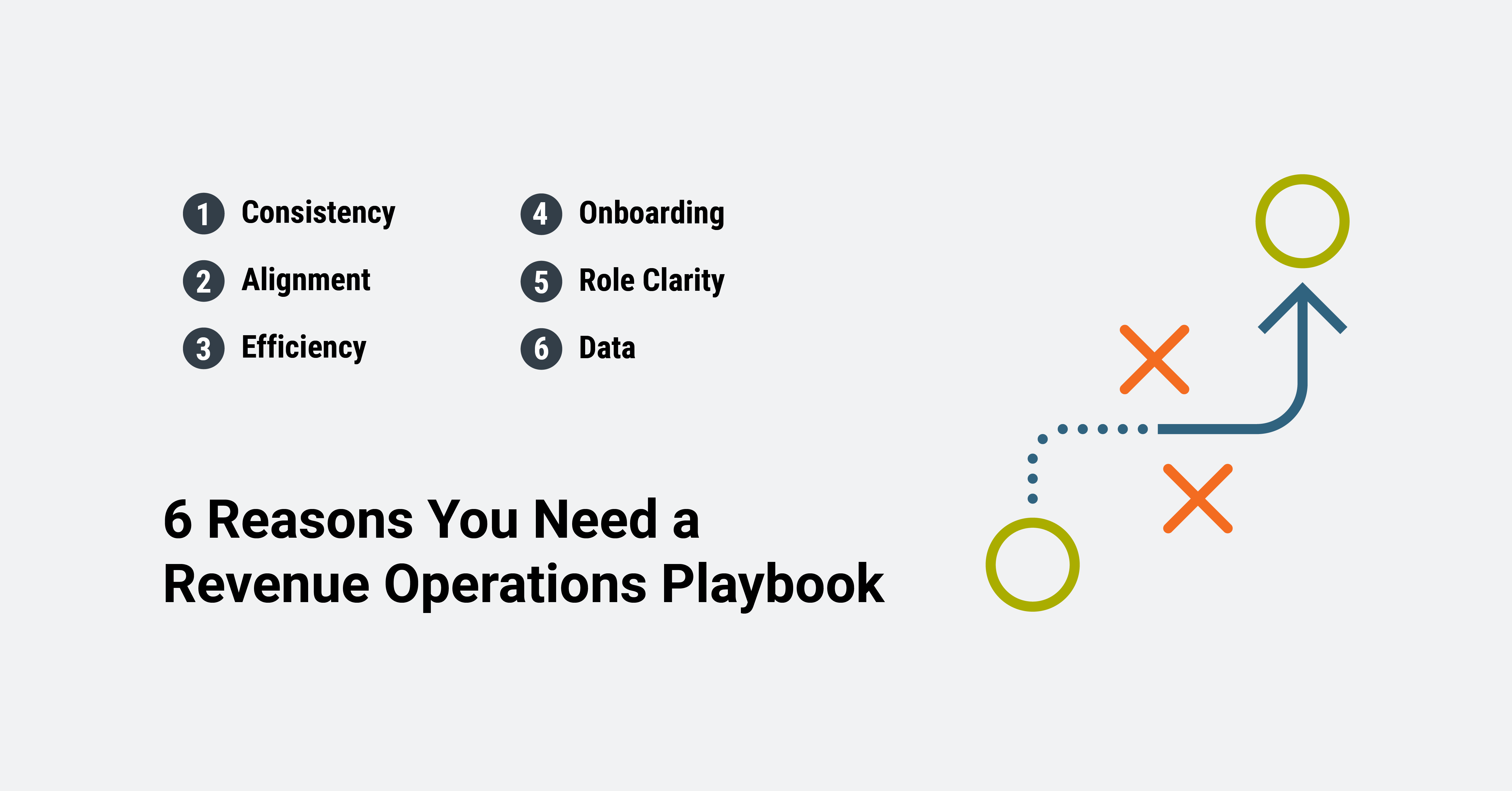
A RevOps playbook sets out a clear plan of action around each of the main activities your business undertakes to generate revenue — for example, marketing and promotion or, to be even more specific, content marketing. This helps ensure a degree of uniformity and consistency across the whole organization.
A RevOps playbook brings all your team members across various departments or functions closer together and puts them on the same page regarding RevOps goals.
A RevOps playbook allows you to document all your processes and workflows in one place where everyone can easily find them easily. This helps team members understand where they fit into the RevOps team structure, reducing bottlenecks and confusion points so all of your teams and activities can operate more smoothly.
A RevOps playbook makes bringing new team members on board much easier giving them the information they need in one easily accessible document. This reduces the learning curve and sets the right expectations from day one.
By clearly defining roles, responsibilities, duties, and expectations for each team and even individual team members, a playbook can help reduce problems like overlapping jobs and gaps. You’ll drive smoother, more efficient collaboration where everyone knows what they need to do.
If your RevOps playbook contains guidelines for data collection, analysis, and use, you’ll help your teams gain better insights from that data. This allows them to make informed decisions, identify trends, and improve strategies as they learn more.
So, how do you go about building a RevOps playbook? There’s no one-size-fits-all approach, and the path you’ll take depends on your specific goals and the structure of your business.
At Marsden, we recommend following this roadmap for the best results.
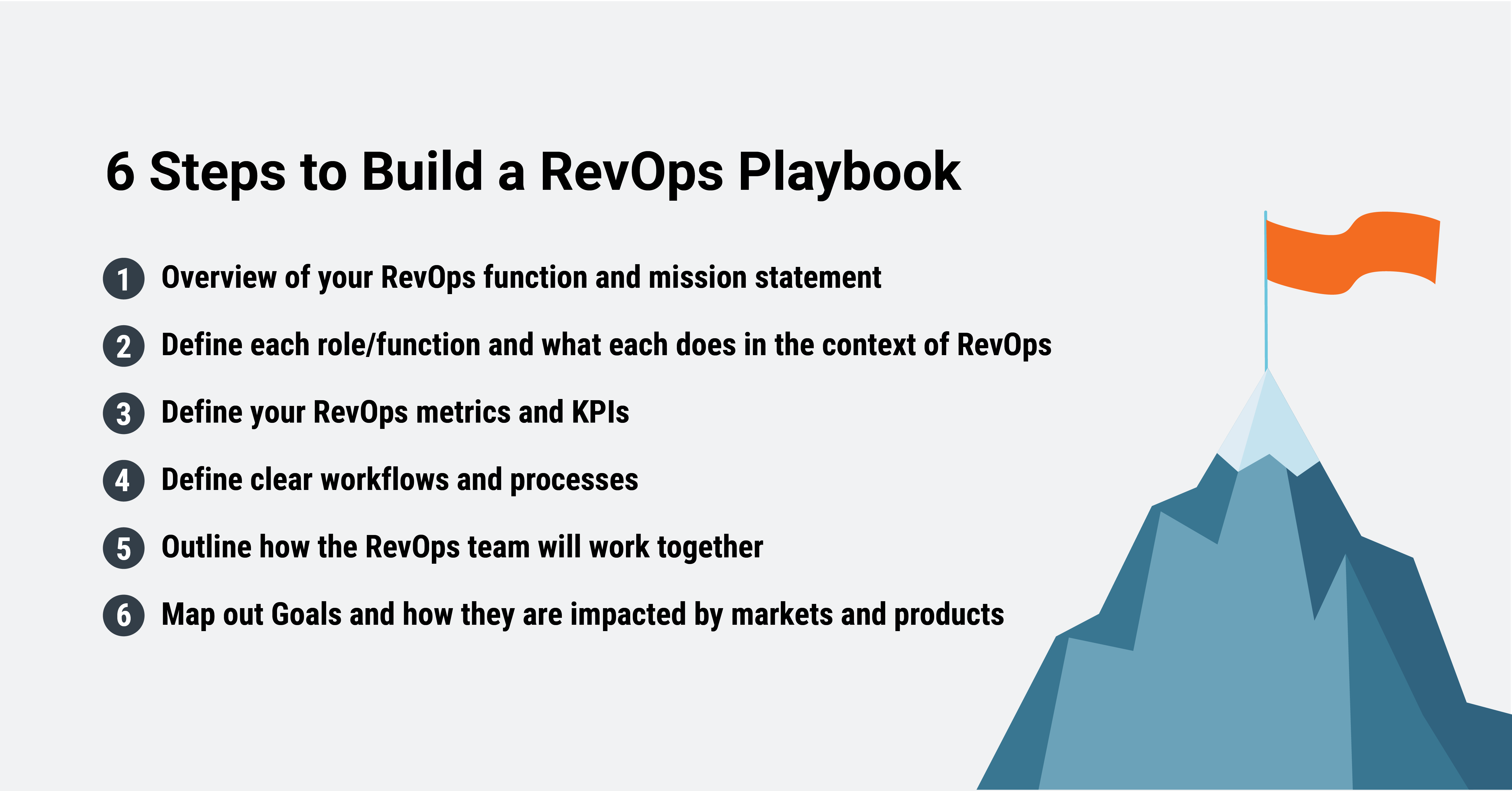
The first stage of planning your RevOps playbook is to be sure that you have a clear understanding of the overarching vision for your RevOps journey.
What exactly do you want to achieve with RevOps? What does a best-case scenario look like? This is where you’ll want to look at the bigger picture — what broader company goals will your RevOps strategy serve?
This stage also lets you clarify your fundamental values and principles around RevOps. Some examples include transparency, customer-centricity, and being data-driven.
You may want to draft a specific mission statement here. This brief description of your broader RevOps mission highlights your key goals, principles, and plans to achieve your objectives.
Not everyone in your organization will have a role in your RevOps strategy, but many will, even if only a small one.
Your RevOps playbook is the place to define these roles and how they work within your overall RevOps function. Sales operations, marketing operations, revenue analytics, and customer support/success operations are all key parts of RevOps.
Documenting how these functions play together helps bring team members into closer alignment, understanding their responsibilities and how they intersect and work with others. Clearly outlining this in the playbook reduces confusion, overlapping work, and team disconnect.
Tracking your progress is an essential part of RevOps' success.
One of the leading causes of misalignment and dissonance between sales and marketing teams, for example, is their focus on different goals and tracking various metrics. When revenue goals are not achieved, this can result in conflict between these two teams.
Having sales and marketing responsible for the same KPIs brings them together and makes it much more likely that they’ll work together effectively to reach these shared goals. However, you need to make sure you’re following the right KPIs.
The metrics you choose to focus on will vary depending on your specific goals and the structure of your company. Here are a few examples of standard RevOps metrics to track:
Carefully tracking the right metrics is important in RevOps because it allows you to take a data-driven approach to the process, making decisions based on solid insights rather than guesswork. This allows you to make changes, tweak what isn’t working, and do more of what is.
Your playbook should outline all the relevant KPIs to track and clearly show your team members how to measure and calculate them. You should also explain clearly why each KPI is important and how it fits into your overarching revenue goals.
Finally, you need to document where your data is coming from. Set a regular reporting schedule and create standardized templates and formats so the relevant team members can see how their data relates to key RevOps goals.
Different teams and roles will have other metrics related to their specific function to focus on, so this is another area where everyone should be aware of how they fit into the overall process.
One of the most important aspects of RevOps is standardization.
Just like the introduction of the assembly line allowed companies like Ford to produce cars much faster, standardizing your workflows and processes allows your various RevOps teams to work more efficiently and smoothly.
You’ll need to carefully document all your processes and workflows within the RevOps playbook. Done right, this can be highly effective in smoothing out bottlenecks, reducing delays, and minimizing friction between teams.
This leads us to the next step.
RevOps is all about alignment and collaboration between the different parts of your organization, especially in the context of the customer journey,
Step five is where you combine all the previous steps and how all these functions, activities, and processes come together to drive your overall revenue goals.
For RevOps to work, your team(s) must understand the customer journey and where their responsibilities and activities fit into it. Your playbook should always have the customer journey in mind and continuously link to it.
A great place to start is by setting up a customer journey mapping exercise where your RevOps players come together to visualize and define all the key touch points and interactions customers have with your brand. This builds a deeper understanding of your customers, brings your teams into closer alignment, and helps identify new opportunities to build stronger relationships.
To make this work, it’s essential to set a clear schedule for how frequently teams will meet and specify how they will communicate (in-person meetings, Zoom meetings, Slack channels, and so on). One of the primary goals of RevOps is to ensure that your different teams aren’t working in silos, which means you’ll need regular and ongoing communication to review “old plays” and plan new ones while keeping everyone aligned and informed.
Market forces and your specific products will, of course, have a significant impact on your revenue goals.
As a result, your RevOps playbook should focus on how your goals are impacted by markets and developing products and what this means for your team members and their roles.
Often, these forces are both beyond your control and difficult to anticipate. You will need to create contingency plans for potential disruptions which can be devastating such as:
You should be constantly working to predict and prepare for the future. This is where visibility into the right data is critical — win/loss reports and client complaints can be great warning signs, alerting you to potential issues in advance so that you can make the right course corrections before it’s too late.
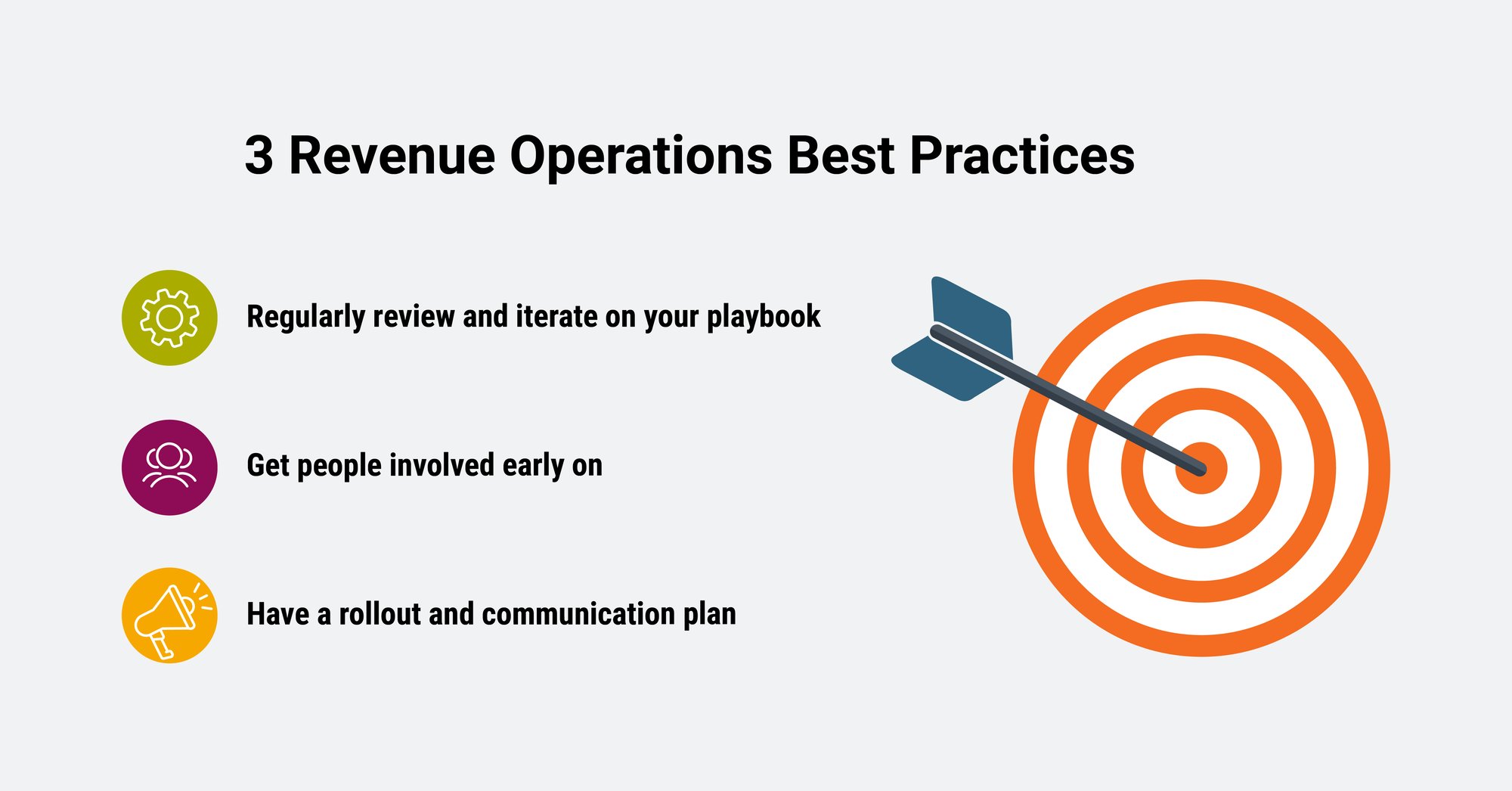
A RevOps playbook is not static. You need to constantly review and iterate on your playbook, updating the information inside as you gain new insights and your circumstances change.
It’s often helpful to have regular meetings where you’ll review various elements of your RevOps strategy, like key revenue goals and targets, marketing and sales activities, and salient metrics, to update your playbook appropriately.
Just as RevOps is an inherently collaborative process, the same applies to your playbook.
It’s important to get the right people involved from the start. Typically, this involves representatives from all the functions you want to consolidate — for example, key players in marketing, sales, and customer success/support.
Bringing in key stakeholders to work together on building the playbook gives you the benefit of different, relevant perspectives and skills while keeping key decision-makers informed and aligned from the start.
Rolling out your playbook needs to be planned. This allows you to make the process as smooth and friction-free as possible.
First and foremost, your playbook is a communication tool, so building good habits from the beginning makes sense.
Here are a few best practices for rolling out your playbook:
Putting RevOps Best Practices Into Action
Now, it’s finally time to bring everything together and start work on your RevOps playbook. If you follow the steps and best practices outlined in this guide, you’ll start from a strong position, with a clear roadmap.
Creating a RevOps playbook is a learning process, and your plans and expectations will likely change along the way. As long as your overarching goals and mission remain in plain view, you’ll be on the right track.
B2B growth marketing+pr agency Trevelino/Keller acquired Marsden Marketing in 2024, including its industry-leading MM Growth Marketing solution, powered by a data-forward approach rich in technologies including HubSpot, Salesforce and Pardot.
1042 Northside Drive NW
Suite 960
Atlanta, GA 30318
(404) 214-0722
info@marsdenmarketing.com